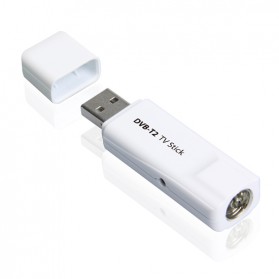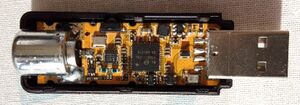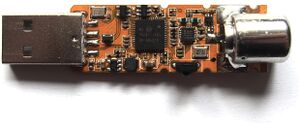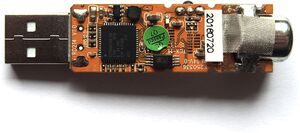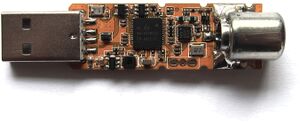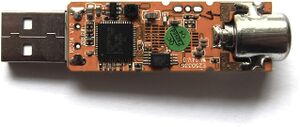Geniatech T230C: Difference between revisions
(→Supported streams: It can be fixed with CrazyCat branch) |
No edit summary |
||
| Line 1: | Line 1: | ||
[[File:Geniatech-t230.jpg|thumb|Geniatech T230C]] |
[[File:Geniatech-t230.jpg|thumb|Geniatech T230C]] |
||
[[File:MyGica T230C.jpg|thumb|MyGica T230C]] |
[[File:MyGica T230C.jpg|thumb|MyGica T230C, PCB in case]] |
||
[[File:MyGica T230C PCB 1.jpg|thumb|MyGica T230C PCB (top)]] |
|||
| ⚫ | The '''Geniatech T230C''' (also branded as MyGica T230C |
||
[[File:MyGica T230C PCB 2.jpg|thumb|MyGica T230C PCB (bottom)]] |
|||
[[File:eyeTV T2 PCB 1.jpg|thumb|eyeTV T2 PCB (top), note the missing IR receiver (bottom right)]] |
|||
[[File:eyeTV T2 PCB 2.jpg|thumb|eyeTV T2 PCB (bottom)]] |
|||
| ⚫ | The '''[[Geniatech]] T230C''' (also branded as '''MyGica T230C''' with a black case instead of a white one) is an evolution of [[Geniatech_T230|Geniatech T230]]. Although it has the same external appearence, it uses different hardware, and is not supported by mainstream 2016-grade kernels. The MyGica-branded device can be found on websites that ship hardware directly from China. |
||
The '''[[Elgato|eyeTV]] T2''' is the same device, just without IR. Targetting a Mac OS audience, it is 5 to 6 times as expensive as the MyGica T230C which does feature IR support (and comes with a 28-button remote control). The eyeTV T2 case is silver/grey with a transparent cap. |
|||
The device can be used with the PadTV HD app on Android if connected via a USB OTG adapter. That app supports H.265, but the phone must be fast enough. On Windows, [https://redeemer.biz/images/dvb-t2-hd/T230C-Driver.rar 28 Jun 2017 drivers] (shipped with some devices in 2018) are required to prevent frequent blue screens in nearly all apps. |
|||
Revision as of 15:44, 17 March 2018
The Geniatech T230C (also branded as MyGica T230C with a black case instead of a white one) is an evolution of Geniatech T230. Although it has the same external appearence, it uses different hardware, and is not supported by mainstream 2016-grade kernels. The MyGica-branded device can be found on websites that ship hardware directly from China.
The eyeTV T2 is the same device, just without IR. Targetting a Mac OS audience, it is 5 to 6 times as expensive as the MyGica T230C which does feature IR support (and comes with a 28-button remote control). The eyeTV T2 case is silver/grey with a transparent cap.
The device can be used with the PadTV HD app on Android if connected via a USB OTG adapter. That app supports H.265, but the phone must be fast enough. On Windows, 28 Jun 2017 drivers (shipped with some devices in 2018) are required to prevent frequent blue screens in nearly all apps.
Overview/Features
Components Used
The following components are used on the device
- USB interface: Cypress CY7C68013A-56LTXC
- Demodulator: Silicon Labs Si2168-D60
- Tuner: Silicon Labs Si2141-A10
Driver support
As of kernel 4.4, drivers are not included in the kernel (at least not in Raspbian 8). Kernel 4.9.24 included in Raspbian 8 (installed when upgrading packages through apt-get) does not support the driver either. However, the driver dvb_usb_cxusb fully supports the device, and can be found in the Video4Linux project. It is possible to build it using CrazyCat's media_build tool.
The T230C appears as a 0572:c689 device
usb 1-1.3.3: New USB device found, idVendor=0572, idProduct=c689 usb 1-1.3.3: New USB device strings: Mfr=1, Product=2, SerialNumber=3 usb 1-1.3.3: Product: EyeTV Stick usb 1-1.3.3: Manufacturer: Geniatech usb 1-1.3.3: SerialNumber: 160421
To be confirmed: it looks like this device is better integrated into LibreElec system (see here how to use the Crazycat-CC driver pack).
Building the driver
The following procedure works (at least) on a Raspberry Pi running 4.4.43-v7+ or 4.9.30-v7+ kernel (but does not seem to work with the 4.9.24-v7+ kernel). It should be pretty similar on other distros and/or with other kernels.
Run apt-get install raspberrypi-kernel-headers to get the correct headers (i.e. the headers corresponding to your exact current kernel build) into /lib/modules/<some folders about your current $(uname -r) kernel version>/. In my case, 2 folders were created: 4.4.43+ and 4.4.43-v7+. In case it does not download the right kernel version headers (there may be a mismatch between uname -r and the folder names in /lib/modules), you can grab the raspi sources by running:
# get the rpi-source tool wget https://raw.githubusercontent.com/notro/rpi-source/master/rpi-source chmod u+x rpi-source ./rpi-source --dest /somewhere/that/has/free/space # Older versions might need to have linux-headers installed into /usr/src and symlinks everywhere in /lib/modules # This is not needed anymore (since mid-2017? Was it even needed at some point?) ln -s /somewhere/that/has/free/space/linux /usr/src/linux-headers-$(uname -r) ln -s /usr/src/linux-headers-$(uname -r) /lib/modules/$(uname -r)/build ln -s /usr/src/linux-headers-$(uname -r) /lib/modules/$(uname -r)/source ...and do the same with uname -r, but without the trailing -v7+ (eg 4.4.43+ if uname -r is 4.4.43-v7+)
Check that a correct .config file (corresponding to the exact current build of your kernel) is available at /lib/modules/$(uname -r)/build/.config It should normally have been fetched by rpi-source. If it was not the case, run modprobe configs, and the .config file that you want is available in the compressed file /proc/config.gz
Now we have the correct sources and .config file, we can fetch the driver sources and build it by using CrazyCat's media_build tool:
git clone https://bitbucket.org/CrazyCat/media_build cd media_build ./build --main-git
Be sure to have some space left, as it downloads a part of the kernel tree.
In case the build fails about frame_vector.c: No rule to make target '..../v4l/frame_vector.c' , comment the following lines in media_build/v4l/Makefile, so that they appear like this:
#ifeq ($(makefile-mm),1) #-include $(obj)/Makefile.mm #endif
Then you can install the drivers by running sudo make install
The process should have installed the correct corresponding firmwares into /lib/firmware. If it is not the case, grab and install the needed firmwares from https://bitbucket.org/CrazyCat/media_build/downloads/dvb-firmwares.tar.bz2.
Firmware
The Geniatech T230C requires these firmwares (available in https://bitbucket.org/CrazyCat/media_build/downloads/dvb-firmwares.tar.bz2):
- dvb-demod-si2168-d60-01.fw
- dvb-tuner-si2141-a10-01.fw
They must be copied in /usr/lib/firmware.
IR Remote Control
If the device is unable to initialize, you may want to prevent the IR from loading:
# cat /etc/modprobe.d/dvb_usb.conf options dvb-usb disable_rc_polling=1
A reboot is needed to take effect.
Supported streams
This DVB-T stick supports every French DVB-T channel (i.e. both HDTV and SDTV, broadcast as MPEG4). They are succesfully processed through tvheadend.
It should support DVB-T2 (it is advertised on the package), although this has not been tested yet.
DVB-C is advertised on the package and is recognized by tvheadend, however this requires the model that includes DVB-C.
Contributions are welcome.
